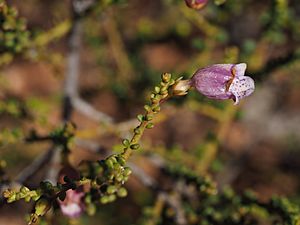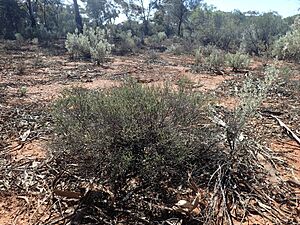Eremophila parvifolia facts for kids
Quick facts for kids Eremophila parvifolia |
|
|---|---|
 |
|
| E. parvifolia subsp. auricampa leaves and flowers | |
| Scientific classification | |
| Genus: |
Eremophila (plant)
|
| Species: |
parvifolia
|
Eremophila parvifolia is a beautiful flowering plant that grows only in Australia. It belongs to the figwort family, called Scrophulariaceae. This plant is a type of shrub with small, often egg-shaped leaves. Its flower buds are dark, almost black, and they open up into pretty purple flowers. Inside, these flowers are white with purple spots. There are two slightly different types of this plant, called subspecies. Both grow in Western Australia, and one of them also grows in South Australia.
Contents
What Eremophila parvifolia Looks Like
Eremophila parvifolia is a spreading shrub. Depending on its type (subspecies), it can be either a low shrub or a taller one.
- Some types are low shrubs, about 50 to 70 centimeters (20 to 28 inches) tall. They have pointy branch tips.
- Other types are taller, growing from 0.5 to 1.2 meters (1.6 to 3.9 feet) high. These don't have pointy tips.
The young branches and leaves of this plant feel a bit sticky. This is because they have a natural sticky substance called resin. The leaves grow one after another along the branches. They are thick, shaped like an egg or almost round, and usually 1 to 5 millimeters (0.04 to 0.2 inches) long and 0.7 to 1.5 millimeters (0.03 to 0.06 inches) wide. Often, they have a purple tint.
The flowers grow one by one where the leaves meet the stem. Each flower sits on a straight, smooth stalk about 1 to 2.2 millimeters (0.04 to 0.09 inches) long. There are 5 overlapping, green or dark purple parts called sepals, which are like small leaves that protect the bud. These are 1.5 to 3.3 millimeters (0.06 to 0.13 inches) long.
The petals of the flower are 6.5 to 10.5 millimeters (0.26 to 0.41 inches) long. They are joined together at the bottom to form a tube. The flower buds are dark brown, but when they open, the outside is purple. The inside of the tube is white with purple spots. The petal tube is smooth, except for the inside and the lowest petal part, which have long, soft hairs. There are 4 stamens (the parts that make pollen) that stick out beyond the petal tube. The time when the plant flowers depends on its subspecies. The fruits are hard, shaped like a cone or almost round, and are 2.5 to 4 millimeters (0.1 to 0.16 inches) long.

How it Got its Name
The plant Eremophila parvifolia was first officially described by a scientist named John McConnell Black in 1928. He published his description in a scientific paper.
The second part of the plant's name, parvifolia, comes from two Latin words:
- parvus, which means "small"
- folium, which means "leaf"
So, parvifolia simply means "small-leaved," which describes this plant well!
In 2007, another scientist named Robert Chinnock described two different types, or subspecies, of Eremophila parvifolia. These names are now officially accepted:
- Eremophila parvifolia subsp. parvifolia: This is the low, spiny shrub type. It usually flowers from June to February and has smooth, almost round fruits.
- Eremophila parvifolia subsp. auricampa: This is the taller shrub type that doesn't have spines. It flowers from September to April and has cone-shaped, hairy fruits.
Where it Grows
Each subspecies of Eremophila parvifolia grows in slightly different places in Australia.
Subspecies parvifolia
This type grows in areas stretching from Balladonia in Western Australia all the way to Fowlers Bay in South Australia. It likes to grow in soil that contains lime (called calcareous loam) in woodlands or shrublands.
Subspecies auricampa
This type is common in Western Australia, found near Norseman and Kalgoorlie, and extending to Balladonia. It can grow in sand, loam, or clay soils. You can find it on sandplains, hillsides, and around the edges of salt lakes.
Conservation Status
The Western Australian Government's Department of Parks and Wildlife says that Eremophila parvifolia as a whole is "not threatened." This means it's not currently in danger of disappearing.
However, the subspecies parvifolia is listed as "Priority Four" in Western Australia. This means it is considered rare or close to being threatened in that specific state, so it's being watched carefully.
Growing Eremophila parvifolia in Gardens
This small shrub is a great choice for gardens, especially for planting between larger plants. It's known to be very reliable, tough, and can live for a long time in a garden – some have been growing for over 25 years!
You can start new plants in a few ways:
- From seed.
- From cuttings (taking a piece of the plant and growing roots from it).
- By grafting (joining a piece of this plant onto the root system of another plant, like a Myoporum plant).
Eremophila parvifolia can grow in many different types of soil, even clay. It prefers a sunny spot. It's also very good at handling dry conditions (drought tolerant) and cold temperatures (frost tolerant).


